Visa Bundle
How Does Visa Dominate the Global Payments Landscape?
Visa, a titan in the payments industry, continuously refines its Visa SWOT Analysis to stay ahead. From its iconic "Everywhere You Want to Be" campaign to its evolving strategies, Visa's approach to the market is a masterclass in adaptation. This analysis will dissect the core elements of Visa's success, offering insights into its sales and marketing strategies.
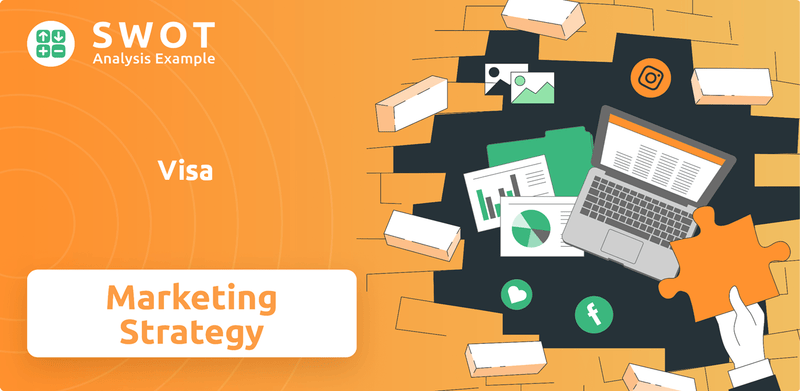
Visa's journey, from BankAmericard to a global powerhouse, showcases a dynamic Visa sales strategy and Visa marketing strategy. Understanding the Visa business model is crucial to grasping how it leverages its network to process trillions in transactions annually. This exploration will reveal how Visa's brand strategy, encompassing Visa payment solutions and a significant Visa market share, has shaped its competitive advantages and fueled its expansion, including its digital marketing initiatives and global marketing campaigns.
How Does Visa Reach Its Customers?
The sales channels of the company are primarily indirect, relying on a vast network of financial institutions globally. This business-to-business-to-consumer (B2B2C) model means that the company's 'sales' are largely driven by the adoption and usage of its payment products by banks and other financial partners, who then market these products to their own customer bases.
These financial institutions act as the direct issuers of cards and also serve as acquirers for merchants. This approach allows the company to reach a broad customer base through established channels, leveraging the relationships and marketing efforts of its partners. The company's success hinges on these partnerships and the widespread acceptance of its payment solutions.
The evolution of these channels has seen a significant strategic shift towards digital adoption and omnichannel integration. While physical retail locations remain crucial, as evidenced by a significant portion of holiday payment volume occurring at brick-and-mortar establishments, the company has heavily invested in digital and mobile platforms. This includes facilitating contactless payments, digital wallets, and online payment solutions.
Key partnerships and exclusive distribution deals with financial institutions are fundamental to the company's growth and market share. These collaborations are essential for issuing cards and deploying their payment solutions to a broad customer base. The company also engages in strategic partnerships with fintech companies and merchants to integrate its payment solutions into digital journeys, aiming for card-on-file and top-of-wallet status.
The company has heavily invested in digital and mobile platforms, including facilitating contactless payments, digital wallets, and online payment solutions. Online retail shopping also saw an increase in holiday spending. This focus on digital channels is crucial for staying competitive and meeting evolving consumer preferences.
The company is working with USAID to drive inclusive digital government ecosystems and payment digitization in emerging markets, including Sub-Saharan Africa, Latin America and the Caribbean, and the Caucasus. Additionally, the company Foundation is investing in initiatives focusing on community development lending and equity in credit unions, specifically aiding affordable homeownership, small business lending, and expanding Minority Depository Institution (MDI) credit unions.
The company's sales strategy is heavily reliant on its partnerships with financial institutions and its digital initiatives. The company's brand strategy and market share are influenced by these collaborations and its ability to adapt to changing consumer behavior. To understand the company's target market, read more about the Target Market of Visa.
The company's sales strategy is primarily indirect, relying on financial institutions to issue cards and acquire merchants. Digital channels and partnerships with fintech companies are increasingly important. The company is expanding into new markets and supporting financial inclusion through various initiatives.
- Indirect sales model through financial institutions.
- Emphasis on digital and mobile payment solutions.
- Strategic partnerships with fintech companies and merchants.
- Global initiatives for payment digitization and financial inclusion.
Visa SWOT Analysis
- Complete SWOT Breakdown
- Fully Customizable
- Editable in Excel & Word
- Professional Formatting
- Investor-Ready Format
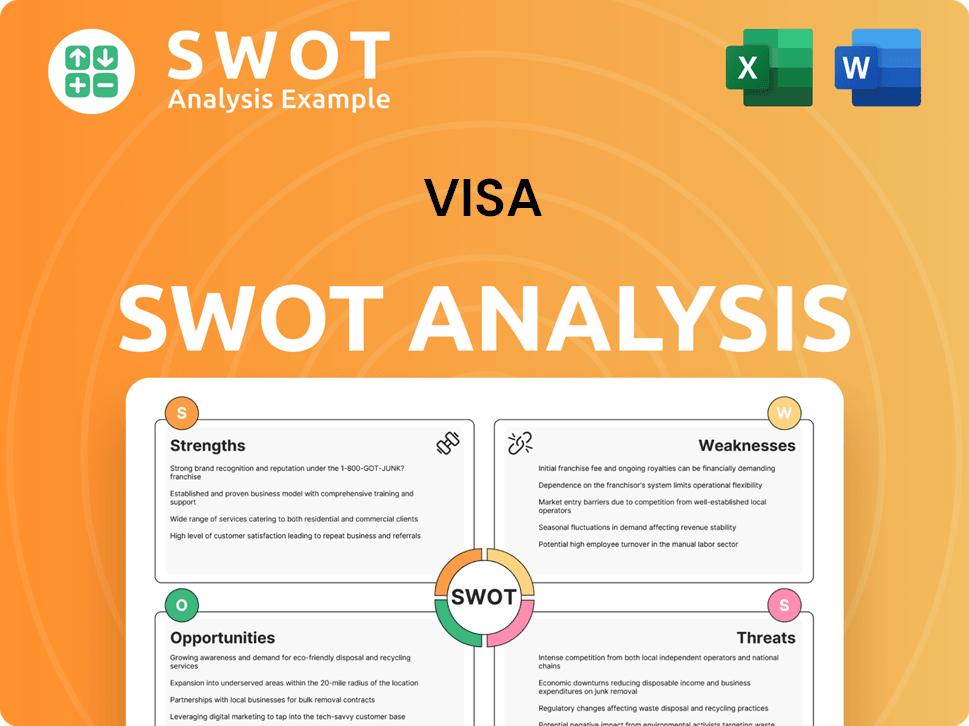
What Marketing Tactics Does Visa Use?
The marketing tactics employed by the company are multifaceted, blending digital and traditional strategies to boost brand awareness, generate leads, and drive sales. The company has adopted a 'digital-first' approach, leveraging AI and data analytics to optimize its marketing investments and understand customer behavior. This comprehensive strategy aims to maintain and enhance its position in the competitive financial services market.
Central to the company's marketing efforts is a strong emphasis on digital channels. This includes content marketing, SEO optimization, paid advertising, email marketing, and active engagement on social media platforms. The company also utilizes traditional media, such as TV and print, particularly for major event sponsorships. This integrated approach ensures broad reach and effective communication with diverse audiences.
The company's data-driven marketing strategy is robust, utilizing its Visa Analytics Platform to gain insights into consumer behavior, spending patterns, and market trends. The platform offers real-time data processing, predictive modeling tools, and customizable reports, enabling targeted campaigns and personalized offers. This data-driven approach allows for precise targeting and effective customer engagement.
The company has embraced a digital-first approach, integrating AI and data analytics to optimize marketing spend and understand customer behavior. This strategy is crucial in today's digital landscape, where a significant portion of consumers research and make purchases online.
Content marketing is a key component, with the company publishing informative blogs and resources on topics like visa eligibility and country-specific immigration policies. This helps to establish the company as a trusted source of information and supports SEO efforts.
Prioritizing SEO, including mobile-first SEO, ensures high search engine rankings for its website. This is vital for driving organic traffic and increasing online visibility, which is essential for the company's Visa sales strategy.
The company actively uses social media platforms like Instagram and TikTok. Initiatives like the 'TakeOn2025' content series highlight creators and new commerce trends, leveraging VisaNet spending data for relevance.
Influencer partnerships are increasingly leveraged, with the company recognizing creators as small businesses. Initiatives like the 'GetP@id' social series mentor aspiring influencers, enhancing brand reach and engagement.
The company uses its Visa Analytics Platform to gain insights into consumer behavior and spending patterns. This platform provides real-time data processing and predictive modeling for targeted campaigns and personalized offers, which is key to the Visa marketing strategy.
The company's marketing mix has evolved, moving from traditional advertising to a digital-first approach, combining data analytics, mobile optimization, and strategic collaborations. This evolution reflects the changing consumer landscape and the need for innovative marketing strategies.
- Data Analytics: Utilizes tools like Hadoop Ecosystem, PySpark, Presto, and SQL for data analysis.
- Mobile Optimization: Ensures a seamless experience for mobile users, reflecting the importance of mobile payments and digital interactions.
- Strategic Collaborations: Partnerships with various entities to enhance brand reach and customer engagement.
- Personalized Offers: Provides targeted offers and rewards based on customer behavior and preferences. For example, frequent travelers might receive offers related to travel insurance.
- Fraud Prevention: Implements strategies for fraud prevention, a critical aspect of maintaining customer trust.
Visa PESTLE Analysis
- Covers All 6 PESTLE Categories
- No Research Needed – Save Hours of Work
- Built by Experts, Trusted by Consultants
- Instant Download, Ready to Use
- 100% Editable, Fully Customizable
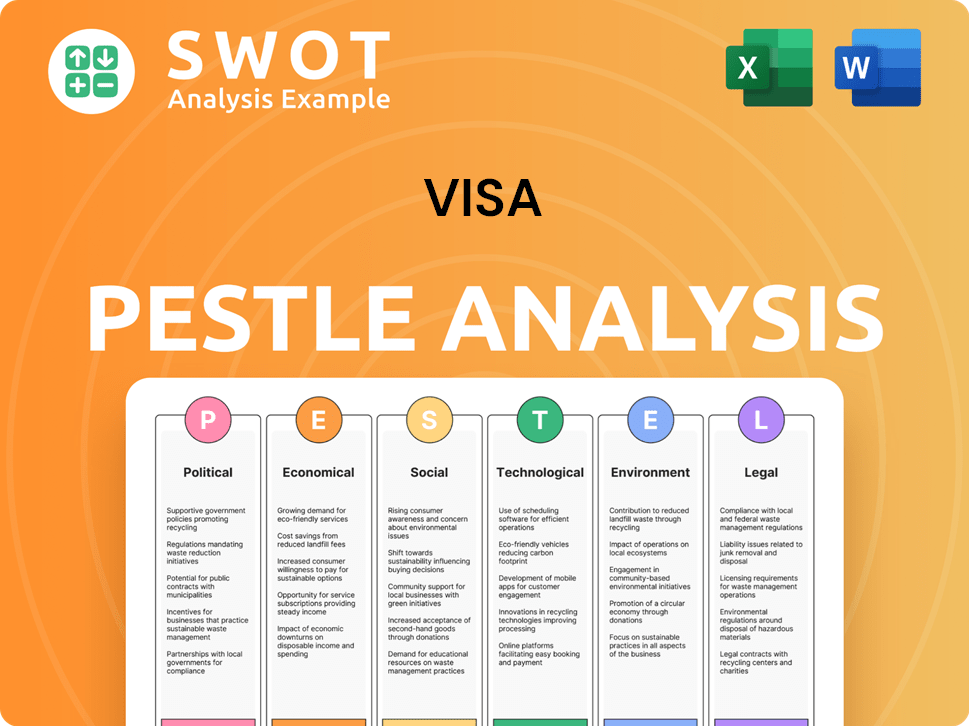
How Is Visa Positioned in the Market?
The core of the brand positioning for the [Company Name] centers on trust, security, and global acceptance. The company differentiates itself as a dependable financial partner facilitating seamless transactions worldwide. This strategy is key to its success in the competitive landscape of Visa sales strategy and Visa marketing strategy.
The brand's message focuses on enabling opportunities and progress, going beyond mere transactions. This is visually communicated through its instantly recognizable core colors, which represent trust, clarity, and optimism. The tone of voice has evolved to be more humanistic and empowering, aligning with the company's mission of economic inclusion.
The company appeals to its target audience by promising convenience, security, and global reach. This is supported by a unified brand presence across diverse platforms, from digital advertisements to point-of-sale terminals and global event sponsorships. The company's consistent brand strategy fosters recognition and trust, which is vital for maintaining and growing its Visa market share.
The brand's identity is rooted in trust, security, and global acceptance. The core message emphasizes enabling opportunities and progress. This is visually communicated through its color scheme, representing trust and clarity.
The company targets a broad audience with a promise of convenience, security, and global reach. This appeal is crucial for retaining and attracting customers. The company's approach is designed to resonate with a wide range of consumers.
Brand consistency is maintained across various platforms and regions, fostering recognition and trust. This unified brand presence is a key strength. Consistent messaging helps in building a strong brand image.
The company continuously invests in innovation, such as real-time payments and B2B services. The 2021 rebranding, with the 'Meet Visa' campaign, marked a shift to a payment technology leader. This was backed by a $9 billion investment in technology over five years.
The company's brand positioning is a critical aspect of its overall strategy. The company's brand strategy is designed to resonate with consumers globally. The company's approach to branding is a key factor in its success.
- Trust and Security: The brand is synonymous with secure and reliable transactions.
- Global Acceptance: The company's network spans the globe, facilitating transactions worldwide.
- Innovation: Continuous investment in new technologies, such as real-time payments.
- Customer-Centric Approach: Focus on convenience and empowerment for consumers.
Visa Business Model Canvas
- Complete 9-Block Business Model Canvas
- Effortlessly Communicate Your Business Strategy
- Investor-Ready BMC Format
- 100% Editable and Customizable
- Clear and Structured Layout
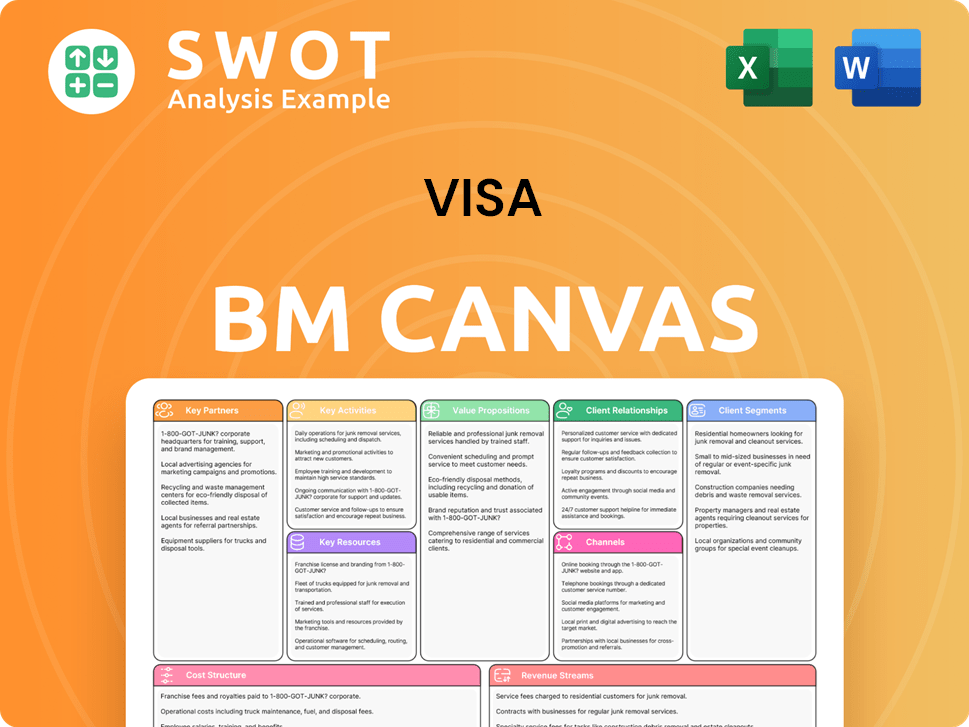
What Are Visa’s Most Notable Campaigns?
The company's sales and marketing efforts are highlighted by several key campaigns that have shaped its brand and driven growth. These initiatives underscore the company's commitment to innovation, financial inclusion, and digital transformation. The company leverages its marketing strategies to connect with consumers globally, fostering trust and promoting its payment solutions.
The company's approach involves a mix of global and localized campaigns, partnerships, and digital initiatives. These strategies aim to enhance its market share and strengthen its position in the competitive payments landscape. Through targeted advertising and community engagement, the company ensures its message resonates with diverse audiences.
These campaigns are designed to reinforce the company's brand as a facilitator of economic opportunity. By focusing on user experiences, the company continues to evolve its marketing approach to meet the changing needs of consumers and merchants. The company's business model and revenue streams are explored in detail in this article: Revenue Streams & Business Model of Visa.
Revived in 2014, this campaign remains a core element of the company's global strategy. In 2025, the 'Typewriter' film redefines this tagline, showcasing how transactions can unlock individual potential. It focuses on broad usage, security, and trust in travel, everyday spending, and e-commerce, resonating with modern consumers.
Launched in 2024, this campaign featured cultural icons, athletes, and artists. It highlighted the power of small steps towards achieving goals, underscoring the company's belief in continuous improvement. This campaign is part of the company's broader brand strategy to connect with diverse audiences.
Extended in 2024, this partnership involves his philanthropic ventures, Black Ambition and YELLOW. It provides financial and digital inclusion tools and resources to students. This collaboration enhances the company's commitment to social responsibility and financial literacy.
Since 2020, the company has invested approximately $3 million in grants and coaching for women SME owners. This initiative supports women entrepreneurs across various countries. It is a key part of the company's financial inclusion efforts and its commitment to supporting small businesses.
The company also supports fintech startups and promotes digital transformation in emerging markets. These initiatives demonstrate the company's commitment to innovation and its role in driving the digital economy. The company's strategies for fraud prevention are also crucial in maintaining customer trust.
- Visa Everywhere Initiative: An open innovation program supporting fintech startups.
- 'Cashless Medina' Concept: Showcased at GITEX Africa 2024, empowering SMEs and artisans.
- Financial Inclusion Focus: Promoting digital transformation and economic opportunity.
- Global Marketing Campaigns: Utilizing data analytics and content marketing to reach diverse audiences.
Visa Porter's Five Forces Analysis
- Covers All 5 Competitive Forces in Detail
- Structured for Consultants, Students, and Founders
- 100% Editable in Microsoft Word & Excel
- Instant Digital Download – Use Immediately
- Compatible with Mac & PC – Fully Unlocked
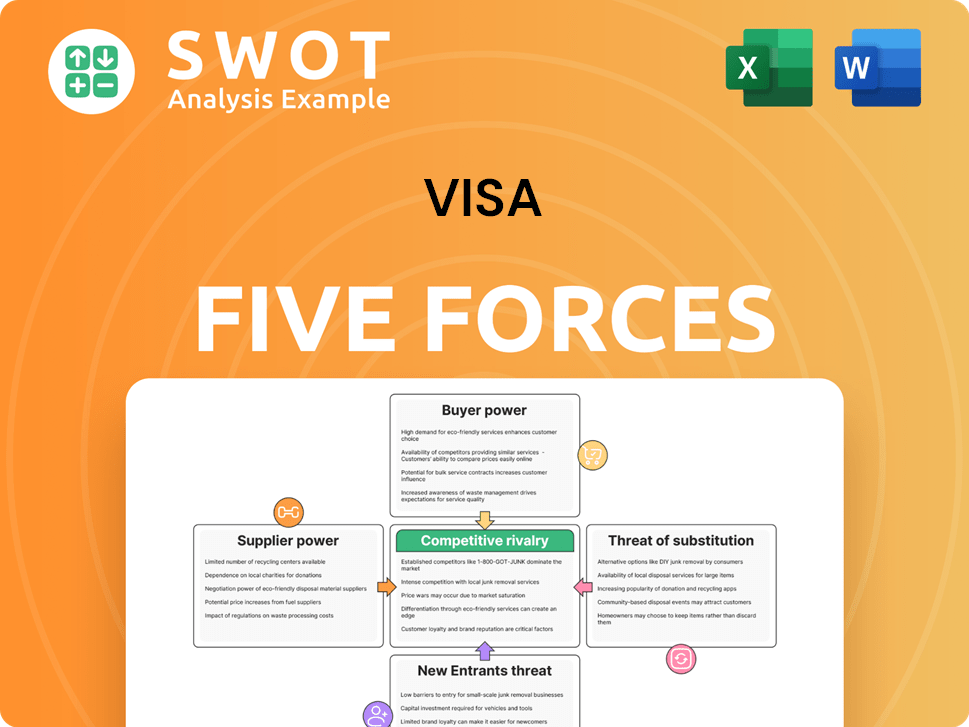
Related Blogs
- What are Mission Vision & Core Values of Visa Company?
- What is Competitive Landscape of Visa Company?
- What is Growth Strategy and Future Prospects of Visa Company?
- How Does Visa Company Work?
- What is Brief History of Visa Company?
- Who Owns Visa Company?
- What is Customer Demographics and Target Market of Visa Company?
Disclaimer
All information, articles, and product details provided on this website are for general informational and educational purposes only. We do not claim any ownership over, nor do we intend to infringe upon, any trademarks, copyrights, logos, brand names, or other intellectual property mentioned or depicted on this site. Such intellectual property remains the property of its respective owners, and any references here are made solely for identification or informational purposes, without implying any affiliation, endorsement, or partnership.
We make no representations or warranties, express or implied, regarding the accuracy, completeness, or suitability of any content or products presented. Nothing on this website should be construed as legal, tax, investment, financial, medical, or other professional advice. In addition, no part of this site—including articles or product references—constitutes a solicitation, recommendation, endorsement, advertisement, or offer to buy or sell any securities, franchises, or other financial instruments, particularly in jurisdictions where such activity would be unlawful.
All content is of a general nature and may not address the specific circumstances of any individual or entity. It is not a substitute for professional advice or services. Any actions you take based on the information provided here are strictly at your own risk. You accept full responsibility for any decisions or outcomes arising from your use of this website and agree to release us from any liability in connection with your use of, or reliance upon, the content or products found herein.